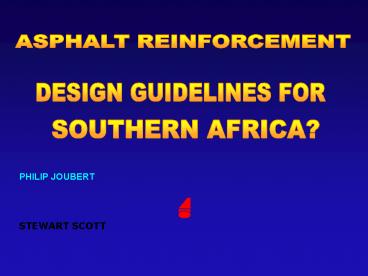ASPHALT REINFORCEMENT - PowerPoint PPT Presentation
1 / 56
Title:
ASPHALT REINFORCEMENT
Description:
Traffic Volumes, Daily E80s. Overlay and Construction Details ... First address structural problems (e.g. potholes, slab replacement) Seal all large cracks ... – PowerPoint PPT presentation
Number of Views:392
Avg rating:3.0/5.0
Title: ASPHALT REINFORCEMENT
1
ASPHALT REINFORCEMENT
DESIGN GUIDELINES FOR
SOUTHERN AFRICA?
PHILIP JOUBERT STEWART SCOTT
2
BACKGROUND
- Based on SAT Seminar (Pretoria)
- Presentations by
- Products
- Cobus Venter Geotrac
- Garth James Kaytech
- Nicholas Reck African Gabions
- Application
- Mynhardt Augustyn VKE
- Philip Joubert Stewart Scott
- Analytical Techniques
- Dr Fritz Jooste Modelling Analysis
Systems - Innovation Planning
- Joop van Wamelen Agrément SA
3
WHY GUIDELINES?
- Products and Purpose
- Applications
- Theory (Modeling)
- The Road Forward
4
WHY REINFORCE ASPHALT?
- Normally during rehabilitation action
- Grids/fabrics laid between old (distressed)
and new asphalt overlay - To Provide Increased Resistance to
- Reflective Cracking
- Fatigue Cracking (strengthen pavement)
- Deformation (Rutting)
- Moisture/Fines Movement
5
PRODUCTS
- Paving Fabrics Geotextiles (Sealmac)
- Glass Fibre Grids Glassgrid / Glasstex
- Polymer Grids Polypropolene (AR - Grid)
- Steel Grids Wiremesh (Road Mesh)
- Composites Grid plus Fabric
6
PAVING FABRIC
7
GLASS FIBRE GRID
8
STEEL GRID
9
COMPOSITE GRID / FABRIC
10
PURPOSE
11
WHY GUIDELINES?
- Products and Purpose
- Applications
- Theory (Modeling)
- The Road Forward
12
RIGHT APPLICATION
13
(No Transcript)
14
TYPICAL APPLICATIONS
15
GLASS GRID FULL WIDTH
16
GLASS GRID FULL WIDTH
17
Percent Crack Reflection by length
GLASS GRID FULL WIDTH
18
GLASS GRID STRIPS
19
USE OF INTERLAYERS
20
GRID AND FABRIC INTERLAYER
21
GRID AND FABRIC INTERLAYER
22
GRID AND FABRIC INTERLAYER
23
(No Transcript)
24
GRID AND FABRIC INTERLAYER
25
CONCRETE SLABS OVERLAY
26
CONCRETE SLABS OVERLAY
27
CONCRETE SLABS OVERLAY
28
GLASSGRID - SETTLEMENT CRACKS
29
GLASSGRID - SETTLEMENT CRACKS
30
PAVING FABRIC
31
(No Transcript)
32
PAVING FABRIC
33
POTENTIAL PROBLEMS
34
POTENTIAL PROBLEMS
35
(No Transcript)
36
POTENTIAL PROBLEMS
37
WHY GUIDELINES?
- Products and Purpose
- Applications
- Theory (Modeling)
- The Road Forward
38
WHY MODEL?
- To investigate effects of
- changing pavement parameters on pavement response
- Given Effect X,
- what is Strain-Y in Asphalt?
- How will asphalt perform at Strain-Y?
39
MICRO EFFECTS UNCRACKED
40
MICRO EFFECTS UNCRACKED
- Thickness and anisotropic effects distort
calculated strains
- Strain unlikely to be reduced by Reinforcement
- UNLESS
- Reinforcement considerably stiffer than Asphalt,
and - there is zero slip
41
Micro Effects Cracked-Behaviour
42
WAY AHEAD?
- Expert Panel / National Interest Group,
- develop code of practice for Southern Africa,
- follow approach Euro committee/ TRB Group,
- formalise sound network management approach
- Product Performance Guarantee?
- Vast potential matrix of operating conditions,
- Difficult to follow this line of approach
- Agrément Certification?
- Standard conformance testing
- Rutting, Beam Tests, Fatigue Testing (MMLS)
- product approval / application type, within
boundary conditions
43
(No Transcript)
44
MICRO EFFECTS CRACKED
- Some modelling is possible using FE
- Layered Elastic modelling not feasible
- Benefits of reinforcement are more obvious for
cracked scenario
BUT Anisotropic effects still important and
likely to underestimate benefits of
reinforcement
45
MODELLING POSSIBILITIES SUMMARY
- Routine modelling is likely to underestimate
benefits of reinforcement
- Routine modelling does not appear feasible at
this stage
Key Problem Impact on damage inhibiting and
crack retardation not evaluated at all
46
WHY GUIDELINES?
- Products and Purpose
- Case Studies
- Theory (Modeling)
- The Road Forward
47
WAY AHEAD
- Build Confidence Focus on field performance and
validation (80 )
- Advanced modelling used mainly to identify key
variables (5)
- Improve routine models to be able to accommodate
transfer functions (15)
48
PRODUCT X OVERLAYS gt 50 MM
Case Studies
BLI
Y-Max
lt 300
lt 95
A,B,C
300 - 600
95 - 130
D,E
F,G,H
gt 600
gt 130
49
CASE STUDY INFORMATION
- Crack Type, Degree and Extent
- Maximum Deflection, Base Layer Index, Test Details
- Support Type and Thickness
- Traffic Volumes, Daily E80s
- Overlay and Construction Details
50
PRODUCT X OVERLAYS gt 50 MM
Not Yet Cracked
Already Cracked
MESA
Base Layer Index
51
REQUIREMENTS FOR GOOD PERFORMANCE
- Material Composition
- High tensile strength at low deformation
- Shear adhesion to maintain good bond
- Thermal and physically stable
- No creep deformation
- Recycle
52
REQUIREMENTS FOR GOOD PERFORMANCE
- Geometry
- Sufficient cross-sectional grid area to redirect
tensile stresses (slip over existing pavement) - Mesh opening to achieve optimum shear adhesion
- Opening such to promote aggregate interlock
- Strip Width beyond crack
53
REQUIREMENTS FOR GOOD PERFORMANCE
- Constructability
- Easy placement
- Remain secure during paving
- Roll width
54
DESIGN GUIDELINES
- Structurally sound (e.g. no excessive movement)
- Evaluate condition (e.g. FWD, Crack Activity
Meter) - First address structural problems (e.g. potholes,
slab replacement) - Seal all large cracks
- Pave leveling course
- Overlay thickness (40mm deeper more effective)
- Tack coat (modify?)
- Consider potential for slippage
- Partial or full coverage (continuous better)
55
SPECIFICATION GUIDELINES
- General description (e.g. glass fibre polymer
covered - Tensile strength (e.g. 50, 100, 200kN/m)
- Elongation at break (e.g. lt5)
- Melting point (e.g. gt200C)
- Mass per unit area (e.g. gt300g/m2)
- Storage (e.g. covered, dry, dust-free)
- Pavement preparation (e.g. cracks, levelling,
clean, damp) - Construction (e.g. tack, ripples, joints,
roller, curves, paver/trucks)
56
WAY AHEAD?
- Boundary operating conditions
- Minimum Joint Efficiency (Crack activity),
- Maximum surface deflections,
- Maximum vertical alignment for rutting)
- National Reinforcement Register
- Identifying solution,
- Anticipated outcomes,
- Design criteria,
- Validation approach
- Validation approach
- Crack mapping,
- Indices,
- TMH9 equivalent approach































